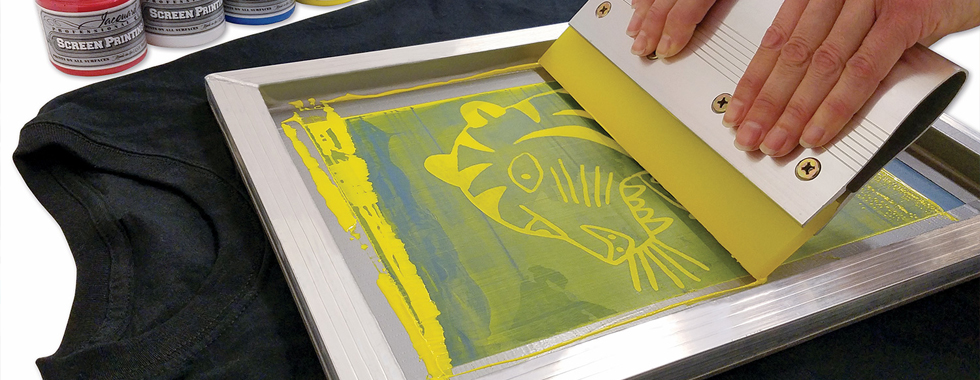ChatGPT said: How 10:9 Design Texas combines creativity and durability in screen printing
The Crucial Overview to Understanding Screen Printing and Its Versatile Uses
Screen printing has an abundant background that dates back to old times, advancing into an advanced method used throughout various markets today. This guide checks out the details of the screen printing procedure, outlining its applications in style, advertising, and home décor - 10:9 Design Abilene. Recognizing these principles can open innovative potential for both creative and commercial jobs. The adhering to sections will disclose important ideas and methods to boost one's screen printing endeavors
The Background of Screen Printing
Screen printing has origins that map back centuries, its development reflects the artistic and technical improvements of different societies. Originating in ancient China, the strategy was at first utilized for enhancing textiles and later infect Japan, where it became indispensable to Ukiyo-e woodblock printing. The technique shifted to Europe in the 18th century, where it obtained popularity among artisans and business printers. The invention of photo emulsion in the 20th century changed screen printing, enabling more detailed styles and higher efficiency. Musicians like Andy Warhol even more pushed its popularity, making use of the medium to develop renowned jobs that combined commercialism and fine art. By the late 20th century, screen printing had developed itself as a flexible strategy, used in vogue, advertising, and art. Today, it continues to progress, integrating electronic innovation and increasing its applications throughout various markets.
The Screen Printing Process Explained
Screen printing transforms creative visions right into concrete styles through a series of specific steps. A photo is developed and after that moved onto a screen, typically made of fine mesh textile extended over a frame. A light-sensitive emulsion is put on the screen, which is exposed to light, hardening in areas not covered by the photo. After rinsing the unhardened solution, a stencil is created.
Next, the screen is put over the substrate, whether it be material, paper, or another product. Ink is then pressed through the open locations of the pattern utilizing a squeegee, depositing the style onto the substratum listed below. This process can be duplicated for numerous shades, needing separate screens for every tone. Ultimately, the printed product is healed utilizing warm to guarantee the ink sticks appropriately, causing a sturdy, vivid design ready for use.
Kinds of Screen Printing Techniques

In addition, specialty strategies, such as discharge screen printing, get rid of color from the fabric to create softer prints, while foil screen printing uses metal foil to accomplish a glossy coating (10:9 Design Embroidery). Each method offers distinctive qualities, dealing with different creative needs and manufacturing ranges, ultimately broadening the possibilities within the screen printing domain name
Applications of Screen Printing in Different Industries

Furthermore, the signs and marketing markets make use of screen printing for creating attractive display screens and banners. This method permits vibrant shades and complex layouts that record focus. In electronics, screen printing is used for applying conductive inks to motherboard, crucial for component links. Additionally, the home décor market accepts screen printing to create unique layouts on fabrics and wall art. On the whole, screen printing offers as an important device across diverse areas, boosting products with personalized and visually attractive graphics.
Tips for Successful Screen Printing Projects
While carrying out a screen printing task, cautious attention to detail can substantially boost the final end result. Selecting top quality products is crucial; this consists of the screen, inks, and substrates. Using appropriate mesh matters can impact ink deposition and information resolution. Prep work is equally essential; detailed cleaning of screens and appropriate exposure times assure crisp prints.
Next off, precise enrollment is critical for multi-color prints. Making use of alignment devices can help attain accurate layering. In addition, testing prints on scrap materials before manufacturing helps determine potential issues without throwing away resources.

Frequently Asked Inquiries
What Products Are Best for Screen Printing on Material?
Cotton and polyester blends are optimal for screen printing on material as a result of their longevity and ink absorption. Additionally, specialty fabrics like silk or canvas can produce unique structures and finishes, improving the total style quality.
Just how Do I Clean and Maintain Screen Printing Tools?
To cleanse and maintain screen printing equipment, one ought to on a regular basis clean screens with suitable solvents, inspect mops for wear, oil relocating components, and shop all products in a dry, dust-free setting to lengthen their life-span.
What Are the Environmental Effects of Screen Printing?
Screen printing can have considerable environmental impacts, including chemical waste from solvents and inks, water More Info use during cleansing processes, and energy consumption. Sustainable practices and eco-friendly materials are crucial for lessening these negative impacts.
Can Screen Printing Be Done in your home Properly?
Screen printing can be properly done at home with the appropriate materials and strategies. Enthusiasts can develop high quality prints, though success depends upon their ability level, devices, and understanding of the procedure included.
What Are the Costs Connected With Beginning a Screen Printing Organization?

Starting a screen printing organization involves prices for devices, materials, and work area. Preliminary expenditures normally vary from a few hundred to several thousand bucks, relying on the range, top quality of machinery, and desired manufacturing capacity.
Screen printing has a rich background that dates back find out here to old times, advancing right into a sophisticated technique made use of throughout numerous markets today. One more strategy, rotating screen printing, utilizes cylindrical screens, facilitating continual printing on material rolls, consequently improving efficiency for large-scale manufacturings. Furthermore, specialized strategies, such as discharge screen printing, remove dye from the textile to develop softer prints, while foil screen printing uses metallic foil to achieve a shiny surface. In the style field, screen printing is widely used to develop vibrant layouts on clothing, making it possible for brand names to showcase their distinct styles. Cotton and polyester blends are suitable for screen printing on material due to their sturdiness and ink absorption.